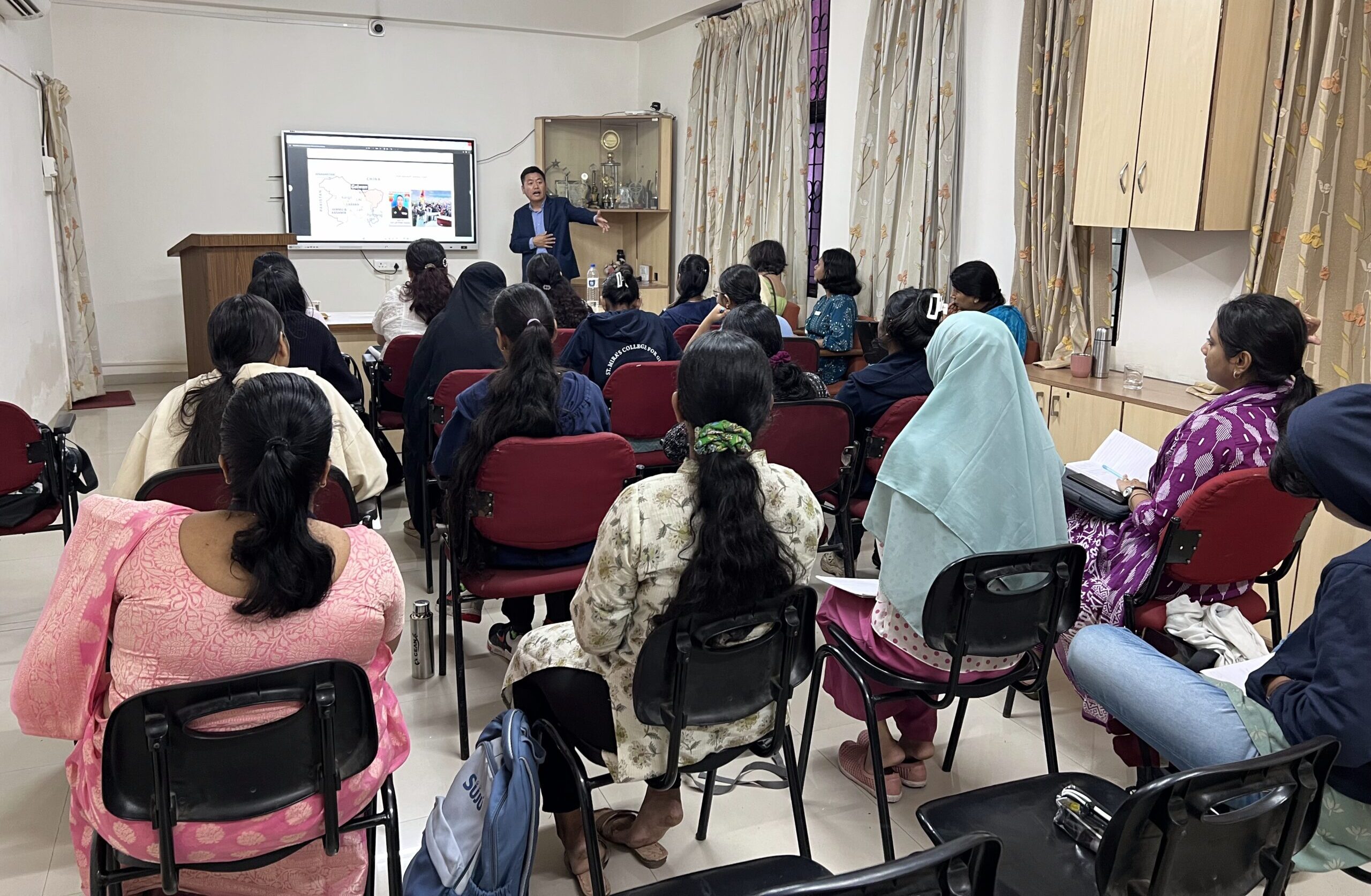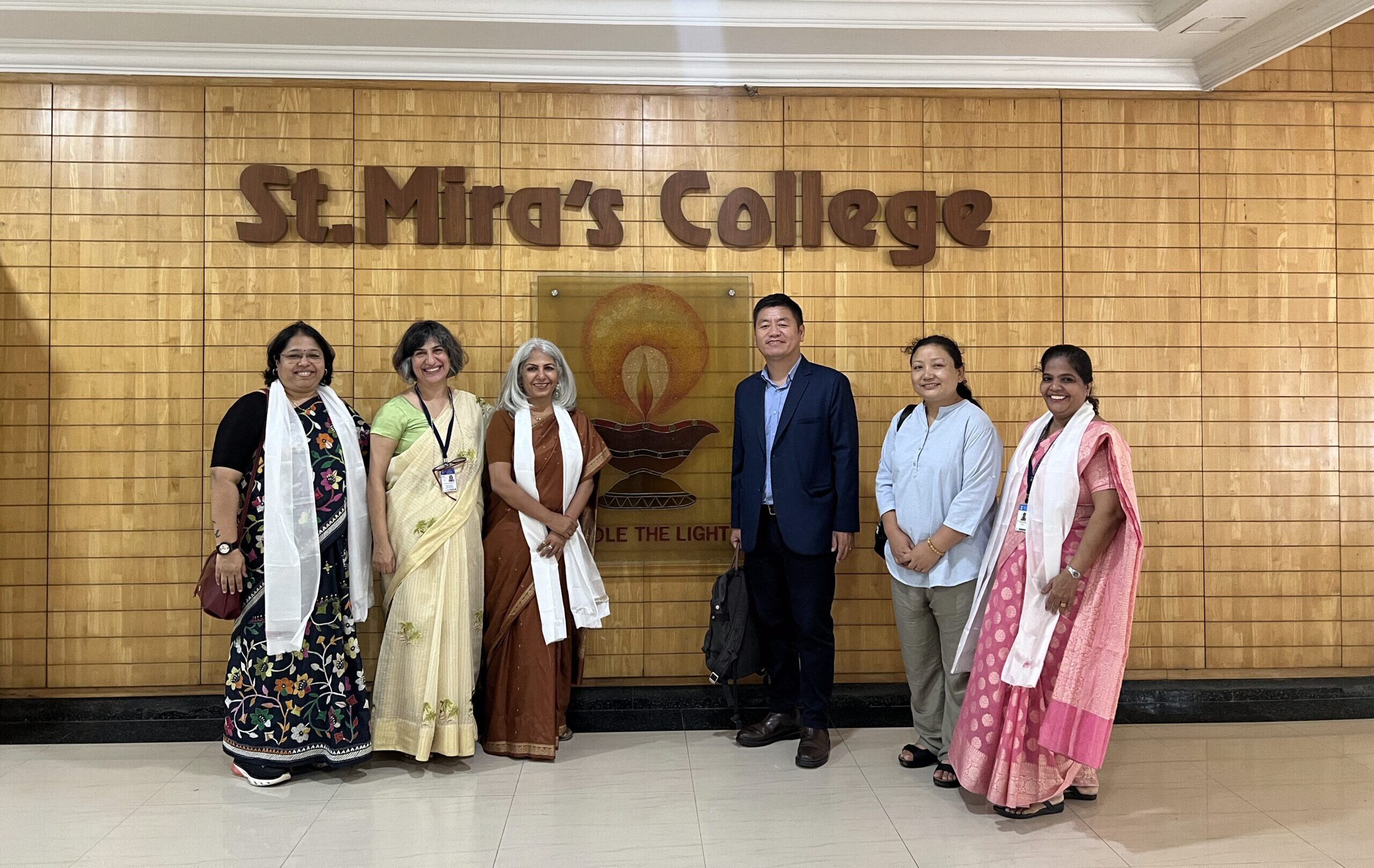On 20th August 2025, the 108 Peace Institute, in collaboration with the Department of Political Science and Public Administration at St. Mira’s College for Girls, Pune, successfully hosted a lecture on Geopolitics of Succession: India, Tibet, and China Relations. The session featured Mr. Dorjee Tseten, Member of the 17th Tibetan Parliament-in-Exile and Asia Program Manager at the Tibet Action Institute, as the guest speaker for the insightful event.
Tibet: A Nation Before Occupation
Opening the lecture, Mr. Dorjee presented Tibet as a fully functioning and independent nation prior to its occupation by China in 1959. He emphasized Tibet’s strategic location, sitting between India and China, with a territory of 2.4 million sq. km—roughly two-thirds the size of India—and a population of six million.
Known as the “Roof of the World” for its high elevation, Tibet is also described as “Asia’s Water Tower” because it is the source of many of the continent’s great rivers, sustaining nearly 1.4 billion people downstream, said the speaker. This unique geographic role, he underlined, has made Tibet not only central to Asia’s ecology but also to its geopolitics.
Tibet’s independent identity, he said, was symbolized by its national flag—an emblem featured in the National Geographic magazine’s 1934 “Flags of the World” issue and publicly displayed at the Asian Relations Conference in New Delhi in 1947.
He went on to highlight Tibet’s diplomatic history, reminding the audience that as an independent nation, Tibet signed treaties with other countries. The 1913 Treaty of Friendship and Alliance between Tibet and Mongolia formally recognized their independence from both China and the Manchu empire. Going further back, he recalled the Tibet-China Peace Treaty of 821–822 AD, signed between Tibetan Emperor Ralpachen and Chinese Emperor Mu Tsung of the Tang dynasty. A key line from the treaty, still preserved on a stone pillar outside Lhasa’s Jokhang Temple, states: “Tibetans shall be happy in the land of Tibet, and Chinese shall be happy in the land of China.”
Mr. Dorjee also pointed to the 1914 Simla Convention, where Tibet and British India negotiated the McMahon Line—today the basis of India’s northern border. He noted that this treaty was signed by independent Tibet, not by China, underscoring Tibet’s sovereign status at that time. Citing Arunachal Pradesh Chief Minister Pema Khandu’s recent statement that “India shares a border with Tibet, not China,” he reaffirmed the historical legitimacy of Tibet’s independence.
Tibet and India: A Shared Spiritual Heritage
Moving beyond geopolitics, the lecture highlighted Tibet’s spiritual and cultural ties to India. Tibetan Buddhism, Mr. Dorjee explained, draws its roots from India’s Nalanda University, the ancient seat of learning established in the 5th century in Bihar. Tibetan Buddhist texts often begin with the words “In the Indian language,” acknowledging their Sanskrit origins and affirming the authenticity of their transmission from India.
Quoting His Holiness the 14th Dalai Lama, he said: “Even though physically my body is Tibetan, mentally I have been nourished by the Nalanda tradition which is a thousand years old.” The Dalai Lama’s fourth lifelong commitment, he added, is to revive India’s ancient wisdom traditions—further proof of the deep cultural link between the two nations.
Tibetans, both inside and outside Tibet, continue to revere India as the land of saints and scholars. According to Mr. Dorjee, this shared spiritual heritage remains a cornerstone of India-Tibet relations, even as political realities have shifted.
Invasion, Uprising, and Life in Exile
The speaker then turned to Tibet’s darkest chapter—the Chinese invasion beginning in 1949 and the subsequent decade of repression. He recalled that under the guise of “peaceful liberation,” the Communist regime unleashed systematic destruction of monasteries, suppression of religion, mass arrests, and the massacre of civilians.
He adds that by 1959, these policies provoked the Tibetan National Uprising in Lhasa, which was brutally crushed. An estimated 1.2 million Tibetans perished as a result of Chinese rule. During this period, His Holiness the 14th Dalai Lama was forced to flee Tibet on March 31, 1959, escorted by Tibetan armies into India through Assam.
In exile, he said, the Dalai Lama worked tirelessly to rebuild Tibetan life. Schools, monasteries, and settlements were established across India, alongside a democratic governance system in exile. These efforts ensured the preservation of Tibetan identity, culture, and spirituality despite the loss of their homeland.
Mr. Dorjee described the Dalai Lama not only as the spiritual leader of Tibet but also as a living symbol of the nation itself, embodying nonviolent resistance against oppression. Globally, he is recognized for promoting universal human values, democracy, religious freedom, and interfaith harmony.
Reincarnation and the Geopolitics of Succession
Addressing the heart of his lecture, Mr. Dorjee warned of China’s two-pronged strategy that poses an existential threat to Tibetan survival.
- Interference in Religion and Reincarnation:
Beijing insists it alone can authorize the recognition of the Dalai Lama’s reincarnation. In 2007, China issued Order No. 5, granting the state exclusive authority over the reincarnation of Tibetan spiritual leaders. This attempt to politicize and control a sacred religious practice, he argued, is aimed at weakening Tibetan Buddhism and eroding Tibetan identity. He recalled the 1995 abduction of Gedhun Choekyi Nyima, the 11th Panchen Lama recognized by the Dalai Lama, who was taken by Chinese authorities at the age of six and has not been seen since—making him the world’s youngest political prisoner. In his place, China installed a state-approved “Panchen Lama,” whom Tibetans reject.
- Erasure of Identity:
Through colonial-style boarding schools, Tibetan children are separated from their families as young as four years old. These institutions are designed to sever cultural, linguistic, and religious ties, thereby undermining Tibetan identity.
Mr. Dorjee further explained that the implications of the geopolitics of succession extend far beyond Tibet. The influence of Dalai Lama and Tibetan Buddhism extends across the Himalayan belt—Ladakh, Sikkim, Himachal Pradesh, Arunachal Pradesh—as well as to Nepal, Bhutan, Mongolia, Japan, Vietnam, the Central Asian Russian republics of Tuva, Kalmykia and Buryatia, and the wider global Buddhist world – Beijing’s push to control reincarnation, therefore, has global implications.
The speaker highlighted the 14th Dalai Lama’s landmark declaration of July 2, 2025, on his succession in which he clearly states, “I hereby reiterate that the Gaden Phodrang Trust has sole authority to recognize the future reincarnation; no one else has any such authority to interfere in this matter.” The statement, he noted, completely defies Chinese overreach in controlling the next Dalai Lama. This historic event was covered by several mainstream media, and there was the presence of over 100 media outlets at a press conference hosted by the Central Tibetan Administration in Dharamshala shared the speaker.
Global Response to the Dalai Lama’s Succession
Mr. Dorjee highlighted growing international support for Tibet, citing the U.S. Tibetan Policy and Support Act (2019), the EU’s May 2025 resolution on religious freedom in Tibet, three pro-Tibet motions passed by the Dutch Parliament in April 2025, and the Scottish Government’s recognition of Tibetans’ right to choose their spiritual leader.
He also referred to a statement from India’s Ministry of External Affairs: “The Government of India does not take any position or speak on matters concerning beliefs and practices of faith and religion.” He pointed out that the spokesperson further affirmed that the government has “always upheld freedom of religion for all in India and will continue to do so,” signaling support for the Tibetan community in India, led by the Dalai Lama, to freely practice their faith.
After the Occupation: Geopolitical Fallout for India
Mr. Dorjee explained that the occupation of Tibet had far-reaching implications for India’s security. With Tibet’s loss of independence, India lost its first line of defence, and the 3,488 km Indo-Tibetan frontier was transformed into a volatile Sino-Indian border.
He recalled Mao Zedong’s “Five Fingers” strategy, in which Tibet was considered the palm and Ladakh, Nepal, Sikkim, Bhutan, and Arunachal Pradesh its five fingers—regions China sought to eventually control. This expansionist vision continues to shape Beijing’s policy, particularly in Doklam and Arunachal Pradesh, which remain critical for India’s security. China claims the entirety of Arunachal Pradesh as “South Tibet” (Zangnan), even renaming locations within the state to reinforce its territorial claim.
The speaker adds that the China-Pakistan military alliance, combined with the China-Pakistan Economic Corridor (CPEC) running through Pakistan-occupied Kashmir, further compounds India’s sovereignty concerns. While India has firmly rejected China’s Belt and Road Initiative (BRI), Beijing’s ambitions in the Himalayas pose an ongoing challenge to peace and stability in South Asia.
The speaker also referred to two articles that reveal China’s evolving military strategy:
- A Swarajya report on Beijing constructing 100 “border villages” along Himalayan frontiers, which the speaker said is part of China’s tactic to consolidate claims over disputed territories.
- A Print report on China recruiting Tibetan youth after the 2020 Galwan clash. However, he noted, such recruitment has declined as Beijing does not fully trust Tibetans to fight against Indians.
Though India lost Tibet geographically as a buffer state, Mr. Dorjee stressed that Tibetans inside Tibet—who continue to revere India as the land of saints and scholars and the birthplace of Buddhism—remain a “spiritual buffer” against China.
In protecting India’s territorial integrity, he honored the memory of Late Mr. Nyima Tenzing, a Company Leader in the Indian Army’s Special Frontier Force (SFF), who became a martyr during the Galwan clash alongside 19 Indian soldiers.
Long-Term Impacts on India
Mr. Dorjee emphasized that China’s attempt to control the Dalai Lama’s succession is a strategic move to extend its influence across the Himalayan region, often described as the “Five Fingers.” He noted that Tibet’s forced assimilation into a centralized authoritarian state has weakened its historic and cultural ties with India, thereby undermining India’s moral leadership in the Himalayas. Additionally, China’s cultural and demographic engineering along border areas like Ladakh and Arunachal Pradesh not only reinforces its territorial claims but also threatens to reshape local identities, posing long-term challenges to India’s security and stability.
The deeply insightful session on the Geopolitics of Succession was attended by first- and second-year students of the Department of Political Science, along with faculty members and the Vice Principal of the college. The lecture became especially engaging as students posed thoughtful questions on the resilience of the Tibetan community in continuing their struggle against an economically powerful China.
In his closing remarks, the speaker reminded participants that while China has occupied Tibet, it has never succeeded in ruling the hearts and minds of the Tibetan people. In response, Beijing has resorted to harsh policies aimed at erasing Tibetan identity—such as interference in the succession of Tibetan spiritual leaders and the forced enrollment of Tibetan children in colonial-style boarding schools.
The lecture concluded with a powerful quote from His Holiness the Dalai Lama’s book Voice for the Voiceless:
“Today’s dark period of Communist Chinese occupation may seem endless, but in our long history, it is but a brief nightmare. As our Buddhist faith teaches us, nothing is immune to the law of impermanence.


